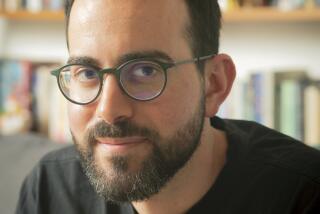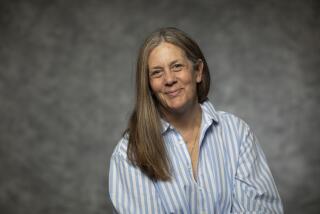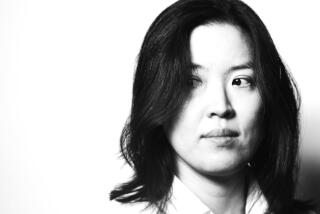A Jumbled Search for Meaning : HOPEFUL MONSTERS, <i> By Nicholas Mosley (Dalkey Archive Press: $21.95; 551 pp.)</i>
Nicholas Mosleyâs novel of ideas--the scientific, philosophical, historical and spiritual ideas of the 20th Century--is a work of soaring intention. So is a card pyramid, until you touch it and it collapses. âHopeful Monstersâ collapses when read. It becomes a jumble of aces, one-eyed jacks, a heart king, a diamond queen, and any number of lower-ranked clubs, spades, diamonds and hearts, strewn around the floor of a book-lined study whose owner infrequently goes out for air.
It runs from the 1920s to the present day. Set variously in Weimar and Nazi Germany, in pre-war and post-war Cambridge, in Britainâs moribund industrial north, in Civil War Spain, in west Africa, and in the Soviet Union during the Stalinist purges, it sends its dual protaganists, Max and Eleanor, on a search for the meaning of our times.
In Britain, âMonstersâ won the 1990 Whitbread Book of the Year award; and no doubt its aim is praiseworthy. Mosley is after an over-arching unity of ideas. How does the upset in physics, brought about by relativity and quantum theory, relate to the fragmentation of the Western polity and the Western individual consciousness? But under the high arches runs the feeblest of fictional streams.
Max, an upper-class English intellectual, and Eleanor, a German-Jewish intellectual, together or separately keep most of the major dates of the past 70 years. The result is not so much a novel as a board game. Call it âGreat Questions of the Era.â Something like:
âAdvance three spaces to the Reichstag Fire. Go back seven spaces and watch Einstein think about relativity. Come forward two spaces as Lytton Strachey shambles up the walk for a Bloomsbury tea. Advance seven more spaces and be present as Francoâs troops rise up and shoot their Loyalist officers in Spanish Morocco. Retreat three spaces and hear Heidegger lecture on Nothingness. Move 15 spaces to New Mexico, and see Robert Oppenheimer and the worldâs first atomic explosion.â
Max and Eleanor are the bookâs great lovers, but theirs is virtually an immaterial love. They spend most of the time apart; the book is set out as a series of long messages to each other. When they are together, there is about as much fleshly warmth as among the characters in an 18th-Century moral-philosophical colloquy.
Max is the dreamy son of a hard-headed Cambridge biologist, and of a droopy literary mother with Bloomsbury connections. âWombsburies,â her husband mutters derisively at them. Max is under his motherâs spell until she droops into having sex with him; thereafter, he turns to science. He is fascinated by the notion that perhaps acquired traits can be inherited.
He experiments inconclusively with salamanders, and asks his father about Lysenko who, obeying Stalinâs demand for ârevolutionary science,â obliges by reporting that he has produced a strain of two-headed wheat. Is a new strain possible if it is âbadly enough needed?â Max wants to know. To which his father, a no-nonsense Mendelian, retorts: âIt is possible that a new strain of Soviet scientists might be found if it is badly enough needed.â It is one of the bookâs sharper lines; the others tend to be woolly and discursive or, in the fiction bits, woolly and lyrical.
While Max is dabbling in Cambridge, Eleanor is growing up more dramatically in Berlin. Her father is a physicist; a saintly man who has long philosophical talks with his daughter, one arm snugly around her. The saintliness, the long talks, and that arm exacerbate the motherâs mounting hysteria. She is Jewish, a communist and a close friend of Rosa Luxemburg, who is murdered in a right-wing putsch. When Hitler comes in, the mother will be arrested and die in a concentration camp, the father will work from the inside to delay Germanyâs atomic bomb program, and Eleanor will escape to Switzerland.
Before all this happens, she and Max meet at an encampment of the Wandervogel ; a youth movement that sent young Germans and Austrians hiking the woods and mountains, singing songs, and thinking about their national and spiritual roots. It was 19th-Century Romanticism mixed with an over-ripe touch of early 20th-Century sex.
Their meeting is brief, high-flown and lush. For much of the time, Mosleyâs style reflects this lushness, this suggestion of pourriture noble. In its romantic moments, in fact, âHopeful Monstersâ suggests a 1920s German novel written by an Englishman. Even the English seems odd. âMy mother had for long had connections with Cambridgeâs Bloomsbury fringe,â Max tells us. Or, addressing Eleanor: âWere you perhaps to me one of those ladies in the Middle Ages for whom knights went out to do heroic deeds: the knights could not stay except for moments with their beloved ladies, or where would be the heroic deeds?â This from the German translated might be.
The lovers go their separate ways. Max returns to Cambridge, studies physics, and is the target of overtures from Melvyn, a homosexual Stalinist modeled on the late Guy Burgess. Melvyn introduces him to Mullen, his professional handler, who, though a spy, is also a true believer. Mullen is one of a number of good men--there is also a Nazi and a Spanish Falangist--whom Mosley places at the heart of evil. His image is cabalistic: The Seven Just Men, unknown to the world, who will save it.
The Cambridge scenes, written with irony and a lovely sense of place, are the best in the book. They are followed by an extended, windy vagary in which, after other separate adventures, the lovers meet in Spain. Max is there to cover the Civil War for a left wing paper; he gets fed up, sets out on foot to repeat the medieval pilgrimage to Santiago de Compostela, and is locked up in a monastery. Eleanor, who has been anthropologizing in west Africa, crosses the Sahara to Spanish Morocco and goes on to Seville, which is just then falling to the Franco forces. She comes under the protection of an aristocratic Nazi--a Just Woman--who runs a Nationalist hospital. Eventually she works her way up to the Pyrenees and plucks Max from his monastery.
The story bloviates on, rarely achieving any greater focus or fictional favor. Max becomes a great man, working on the frontier of physics and biology. Eleanor becomes a great woman, working on the frontier of anthropology and psychology. They live separate lives, have affairs, always come back together, and remain true to each other in their high historical fashion. When we last see them, Max is near 80 and dying of cancer, and Eleanor is sitting on his bed. We are told, in the last line, that Max will not die. The cancer will.
It hardly matters. Neither he nor Eleanor are really alive. They are two flapping sails that catch at the centuryâs winds to propel Mosleyâs vessel and its load of philosophic and historical speculation.
More to Read
Sign up for our Book Club newsletter
Get the latest news, events and more from the Los Angeles Times Book Club, and help us get L.A. reading and talking.
You may occasionally receive promotional content from the Los Angeles Times.







